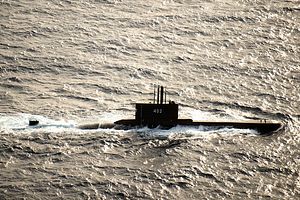This week, Philippine Defense Secretary Delfin Lorenzana made headlines when he suggested that Manila was currently mulling options for the pursuit of a submarine capability. Though Lorenzana’s comments were just the latest restatement of Manila’s long pursuit of submarines, it nonetheless once again highlighted the role of the capability within the context of the country’s ongoing military modernization under President Rodrigo Duterte and the significant challenges and lingering questions in moving forward with this potential acquisition.
As I have noted before in these pages and elsewhere, the idea of the Philippines developing a submarine capability is not a new one and dates back to at least the 1990s. Since then, the Philippine government has studied the issue and has in fact already taken some initial steps towards that long-term goal, including setting up a submarine office in 2013 and including it as a potential line item in its longer-term military modernization plans (See: “Will the Philippines Ever Realize its Submarine Dream?”). This has come as some of its neighbors, including Indonesia, Malaysia, Singapore, Thailand, and Vietnam, have all moved to either acquire submarines or expand or upgrade their existing capabilities.
The Philippine pursuit of a submarine capability continues to make the occasional headlines under Duterte, especially as the country thinks about it future military modernization. And this week, we saw another round of headlines on this front when Defense Secretary Delfin Lorenzana said that the Philippines was currently looking for potential suppliers for its submarine pursuit. In his comments, Lorenzana said that though submarines were a capability that were to be acquired under the third horizon of Philippine military modernization from 2023 to 2027, Manila was nonetheless now looking at suppliers, including South Korea and Russia, to examine the country’s options on that front.
Lorenzana’s comments themselves were not really that groundbreaking. As noted before, the Philippines has long been mulling a submarine capability and had already taken preparatory steps in that direction even before Duterte came to power, and so it makes sense that this is continuing. Submarines are also a large and long-term investment, so it is understandable that a country would want to look at its options carefully before pursuing them, especially with countries with which it has already been dealing with on the defense side such as South Korea.
Interestingly though not surprisingly, in his expressed rationale for acquiring submarines, Lorenzana, as some other officials have done in the past, chose to emphasize the fact that the Philippines needed to pursue the capability because several of its neighbors already have submarines. In doing so, he was reflecting the ‘keeping up with the Joneses’ mentality that has pervaded other states mulling the capability over the years that I have written about before in reference to other militaries.
To be sure, that mentality does in part speak to political realities in the region, whether it be the continued competitiveness among Southeast Asian states in the defense realm or the utility of using arguments that rely on relative power – rather than rigorous cost-benefit analysis – in order to politically and publicly justify big-ticket procurements that privilege certain services over others. It is also far from surprising that we are far more likely to hear more general reasoning around ‘competitiveness’ or ‘deterrence’ in public from policymakers rather than the more detailed articulation of specific rationales for acquisitions that occur in more private settings.
Yet, at the same time, as I have observed before and Lorenzana himself is no doubt aware, those kinds of arguments are nonetheless problematic because they paper over the real issues that need to be carefully considered at the outset when making those big-ticket procurements like submarines. In the case of the Philippines in particular, despite significant investments over the past few years, it still remains once of the region’s weakest militaries, lacks some basic capabilities including adequate maritime domain awareness, and faces a range of internal and external threats that it needs to confront in spite of resource constraints. In that context, relative to some of the other investments that need to be made in the next few years, investing in a submarine capability would be an expensive investment – in terms of not just the equipment itself, but also supporting people, technology, and facilities.
To be sure, there are ways of managing these constraints, whether it be selecting more cost-effective suppliers or seeking assistance from allies and partners with respect to certain capabilities. But these options are much more difficult to execute than often appreciated, and they take foresight and follow through to get to implementation. Irrespective of how things play out though, it is fair to say that these sober realities will remain for the Philippines, irrespective of the arguments which its officials choose to advance or not to advance. And if the country chooses to actually move more definitively from rhetoric to reality in its pursuit of submarines, it will have to grapple with them in the coming years and long after Duterte departs office.































